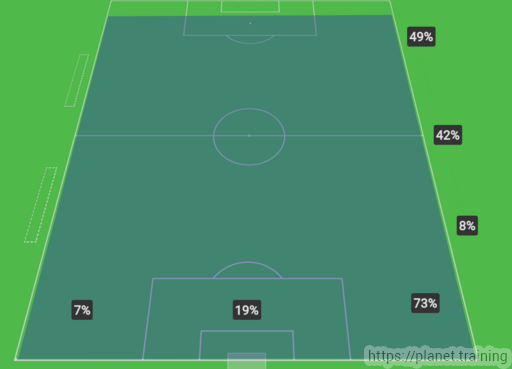WORLD CLASS COACHING
Pep Guardiola Attacking
By Luca Bertolini
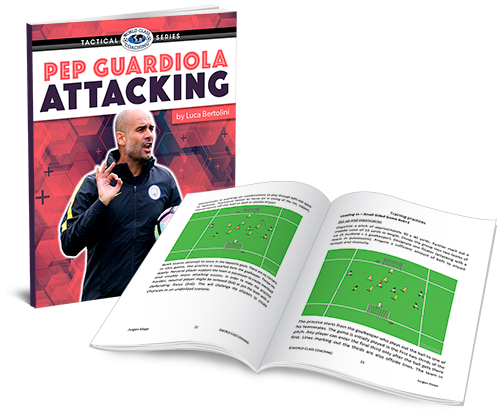
Table of Contents
PART ONE
Introduction
Manchester City's 2017/18 Team and Key Players
PART TWO
Formations and Attacking Shapes
PART THREE
Formations and Attacking Shapes Continued
PART FOUR
Counter-Attacking
Set Plays
INTRODUCTION
"I'd rather my players to thank me for improving them, rather than for the titles."
What I want most of all is after each game, and after the season ends, City supporters saying that they have enjoyed the football. That is the most important thing.
I’m here because the Premier League is a huge challenge. I proved myself in Barcelona and again in Germany and now I want to prove myself here with my staff and amazing players.
I want each of my players to be a good teammate; this is the most important quality. I like a player who thinks about himself but also about the group and Manchester City.
I know how hard the Premier League is; it is a tough league in which to put together lots of wins back-to-back. That is a challenge. There are many teams who can finish in first place and the competition will be fierce.
We are all working here to make this club better. I don’t like the guys to think about what the club can do for them. We are here to help Manchester City to become a better club over the upcoming years and hopefully that is what you will see.
We have to try to help each other and go forward and be aggressive without the ball. I like to see the fight when we don’t have the ball because without that we can’t win anything.
We speak and we train, we help each other to see if we can press and build up from the goalkeeper.
These are few words by Pep Guardiola for the Matchday Program before his first Premier League match ever, against Sunderland, on August the 13th, 2016.
The first season was without titles in spite of many new signings: John Stones (center back - 55 mln £), Leroy Sané (winger - 50 mln £), Gabriel Jesus (center forward - 32,00 mln £), Ilkay Gündogan (center midfielder - 27,00 mln £), Nolito (winger 18,00 mln £), Claudio Bravo (goalkeeper - 18,00 mln £).
At the same time the transfers were very poor from an income point of view, with many players on loan: Stevan Jovetic, Edin Dzeko and Wilfried Bony (forwards), Samir Nasri (wingers), Martín Demichelis and Eliaquim Mangala (center backs) and the goalkeeper of the previous seasons, Joe Hart.
At the end of the first season, the team was classified 3rd in the league and it was eliminated in the 4th round of the League Cup, in the round of 16 of the Champions League and it was a semi-finalist of the FA Cup.
These are some thoughts of the manager for "The Independent" on line, about his first season:
“Of course. I thought ‘If it doesn’t work, I’ll go home, another one is coming and someone can try in his way’, so in that moment there was concern about the results, what we can do to improve” [...].
“In that moment I thought that could happen, that it doesn’t work [...].
“But at the same time, I thought if next season it’s not going well, if it’s the same, Txiki (Begiristain, City’s director of football) or Ferran (Soriano, City’s chief executive) would decide ‘OK Pep you are not good enough’ and change...
But: “I said last season many times when I was asked – it works to play my way and I said ‘I am going to insist, so I never had a doubt about that…
The new 2017 market windows brought new and decisive players for the future league title; Kyle Walker - 52,70 mln £, Danilo - 30,00 mln £ (fullbacks), Bernardo Silva (winger - 50,00 mln £), Ederson (goalkeeper - 40,00 mln £) and others like Aymeric Laporte (center back - 65,00 mln £), Benjamin Mendy (fullback - 57,50 mln £).
As for the previous transfer campaign, the players who left the team didn't bring big incomes (Iheanacho, Bony, Nolito, Fernando, Kolarov, Zabaleta, Clichy, Mangala, Jesus Navas).
David Silva, Kevin De Bruyne and Fernandinho became definitively top class players during these two seasons, Aguero was confirmed as the best center forward for his team.
Sterling improved definitely. This is his scoring data and skills:

John Stones, Leroy Sané, Gabriel Jesus, Ilkay Gündogan were decisive for the league title, as well as the new players like Ederson, Walker and Bernardo Silva. Fabian Delph has become a well-known and useful player at the age of 28, after three seasons in the squad.
These are the main general data of Lorey Sanè, comparing his two seasons as Manchester City player:

Here are some average data of Sterling and Sanè as Manchester City players:

And here the same average data of Gabriel Jesus during his first season and half as City forward:

Raheem Sterling stated this about Per Guardiola: "His desire, his attention to detail and his man management will galvanize everyone with whom he comes into contact. Everyone knows he is one of the most innovative and successful coaches there has ever been and I can’t wait to sit back and enjoy the next few seasons.”
Taking advantage of the players’ skills to win is always easier than improving players’ skills. These are some statements from the Matchday Program of the first Premier League match of the last 2017/2018 season:
“The group of players that our fans will watch this season will be the backbone of this Manchester City for a long time. Raheem [Sterling], Leroy [Sané], Gabriel [Jesus], Bernardo [Silva], Mendy, Ederson...all of them are young and will stay for the future and get better.”
“I want to say thank you to the club. For the next four, five years we have players with huge talent who will grow better together. Our average is now is around 24, so it means a lot for the future of the club.”
“It is true that we have a big squad and a lot of midfield players, but there are many games and four competitions, so everybody is going to get time on the pitch. If you want to play in a certain way, the way I like, with players on the ball, then you need exceptional talent. Our midfield options are fantastic. They all have such a lot of quality. All of them are going to play. Last season I rotated the team a lot and I will do that again. They will all be involved. After that it depends on them.”
This is the goal of Pep Guardiola as manager at Barcelona, Bayern and Man City: to win titles, improving and developing his players.
The 2017/2018 team and key players


Both the goalkeepers, Ederson especially, have good skills to play with both feet, as they usually starts all the moves from the back and they are always a back pass option for their teammates. The average of passes per match of the line-up goalkeeper Ederson is very high:

Looking at the data of the defenders, a high number of passes and of key passes can be easily noticed. One of the center backs, Stones, with 29 appearances during the 17/18 season, has played 22 key passes and he has a 94% average of useful passes. He has been always an active player during the building up phases of play.

Otamendi, with 46 appearances during the 17/18 season, has played 45 key passes and he has a 92% average of useful passes. He has a high percentage of useful dribbles, as he is the center back who often tries to invite the opposition pressure.

This is the distribution of his positions on the field; nearly the 50% of all the moves, he has been placed and he has played in the middle third, both dribbling the ball and being positioned as balance player of back line of three.
Thanks to these positions, the advanced midfielders have been able to play near the center forward and to exploit the center space behind the opposition lines.

Walker, the right fullback, has played 62 key passes attempts during this season; he has taken active part to the play out phases of play in the middle third.


The role of Danilo is very interesting; he has played 38 matches throughout the season, as right fullback, as left fullback and as defensive midfielder. They number of the key passes is very interesting.

This is the distribution of his positions on the field;

His starting positions in the line up are for a 61% as right fullback, 32% as left fullback and the rest as defensive midfielder. As left fullback Danilo has often played as inverted fullback, in the middle third, as his teammate Delph.
Fabian Delph, is one of the players who improved himself the most with Pep Guardiola; after the first season on the bench as center midfielder, he has been transformed and developed as fullback, as inverted fullback moreover, exploiting his skills as midfielder.


During this last 17/18 season, he has played 29 matches as left fullback (61%), as center midfielder (22%) and as defensive midfielder (17%). He has the highest percentage of dribbles per match, of cross passes (taking into consideration that City is not a cross oriented team) and a high percentage of useful passes (93%).
As for Otamendi, the main goal of dribbles in the middle third is to invite the opposition out from defensive positions and to invite the pressure, opening spaces at their back and in behind their lines.
Mendy has played moreover as left fullback or left midfielder, in his 9 season appearances; his main characteristic is the crossing skills from the flank, but he played a high number of key passes as well.

All the midfielders either have defensive and balance roles or advanced and attacking tasks, they are well skilled at playing with their weak foot. Build up and "liquid" possession phases require these kinds of player.
The whole squad seems to include just three center forwards as specific role; but, again, the mix of roles and of patterns of play, during the finishing stages, allows all the advanced midfielders to shoot on goal together with their supports moves.
The defenders allow the advanced positions of the midfielders, keeping the balance at the back with a line of three.
Here are some basic data about the Manchester City advanced midfielders, who don’t have a specific role during building up phases of play, but they usually take an active part of playing out in the middle third and during the finishing phases.
The four main midfielders have scored 37 goals at the end of the season, and all their positions on the field have been evenly mixed, except for Bernardo Silva, who aims at playing as inverted midfielder, starting from the right side.

Looking at the following scheme and graphics, low percentages of action in the first third are very explicative of what Guardiola wants from them; the build up phase is not their task, but they basically:
1) must play out
2) move in between the opposition lines
3) take the moves to the final stage
4) run without the ball to be a third man option and a support for the wingers
5) are be able to keep the possession if direct attacks are not possible
6) finish the moves
7) be the first pressure players when the ball is lost
8) launch and support the counter-attacks
This is the scheme of the field coverage of Gundogan, through his positioning. Among the advanced midfielders, he is the one who plays as advanced center play maker, more than all the others. He is often positioned all over the width of the field, but he is active in the middle third, more than in the final third. He played a key role in City’s recent League Cup win, playing all the six matches of the trophy.

The vertical middle line and the center horizontal line identify the main playing area, with a tendency toward the left side of the field.
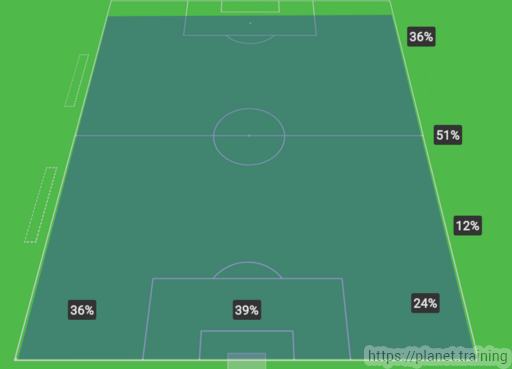
As he plays with a high percentage of successful passes, but with a quite low key passes average, it's clear that his first task is to be an advanced playmaker, to keep the possession high on the field, receiving from the build up area and passing toward the final third. Gundogan has a lower average of positions in the final third and he usually attacks the opposition goal less than the other advanced teammates.
Gundoğan usually moves higher when an inverted fullback is placed inside to create a double play maker situation, with the balance player Fernandinho.
Kevin De Bruyne has been transformed into a total midfielder. He also doesn't start the moves and he becomes very active from the middle third until the finishing phase in the final third.
When City’s wingers are able to push back the opposition fullbacks, he usually has a lot of space to play and he combines with Kyle Walker very often, creating space in which he can run into with overlaps or underlaps. He is able to cover a lot of ground as total freedom is given to the pattern of play creators: free spaces must be always occupied, creating passing triangles around the pitch and playing into the attacking third.
As long balls have appeared into Guardiola's patterns of play to exploit the width of the pitch, De Bruyne is the one of the passers. City’s wingers are often involved in 1v1 situations, after receiving long balls to switch the side; his average of long passes is 3.7 per game, much higher than all the other players.

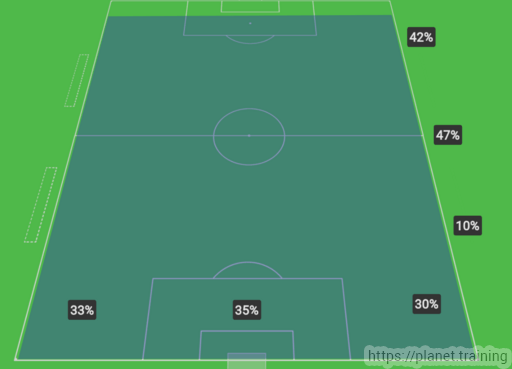
A large number of scoring chances has come from De Bruyne set pieces and crosses as well.
City’s creativity of the possession phase, during the seasons before Pep Guardiola, was used to come from David Silva and it was upgraded thanks to Kevin De Bruyne; both them were playing on the flanks or behind the striker.
After two seasons under Per Guardiola, who wants always to overload the center spaces, David Silva now plays with fast and short passing, protecting the ball in tight spaces, without changing his basic center-left positioning.
He is free to carry out his Spanish style with a patient approach, working up and managing the rhythm in the final third, playing with one touch combinations, which have been very effective. Silva has in fact the highest average of passes per game (77.5), as well as the highest average of successful passes (88.60%).

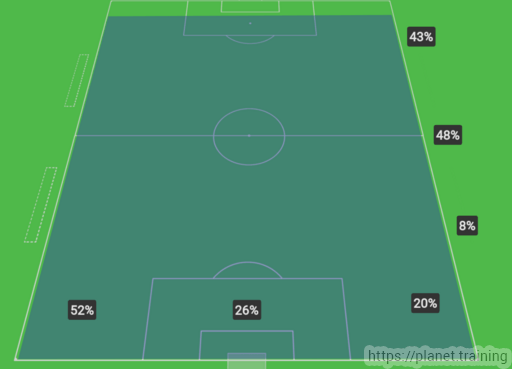
The main difference between D. Silva and Kevin De Bruyne is the Spaniard’s natural inclination to check the options that are based mainly on the positioning of teammates and opposing players when in possession, and to wait with the ball to create new ones if the current ones are not the best possible.
He is able to progress up the pitch to draw a defender or an entire defensive block out of the space, then passing there to find an arriving teammate. David Silva is very good at drawing a defender increasingly close, before making using of the space behind, dribbling around him and into the space.
A new player in the 2017/2018 squad is Bernardo Silva, who played 57 matches, many of them from the bench, with a huge quantity of minutes in all the games, and who has been utilized as inverted winger on the right side of the final third.
His basic task is to play 1 v 1 just like Leroy Sanè does on the left side.

